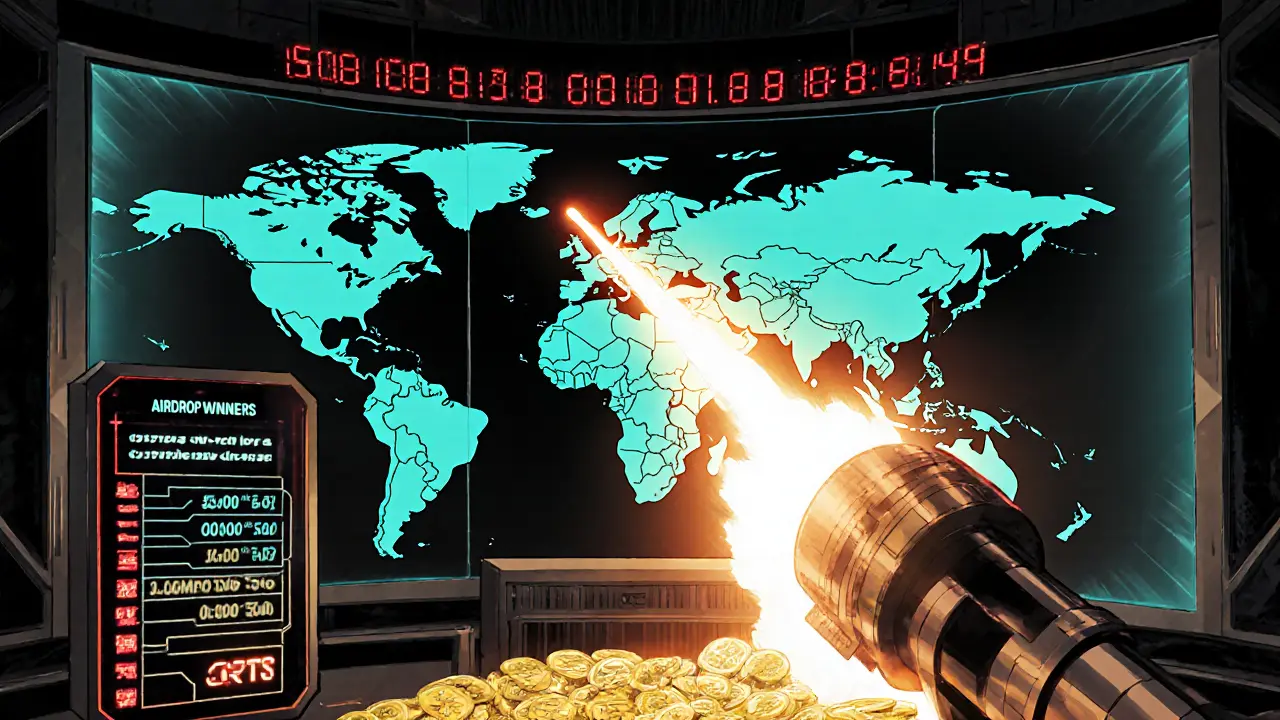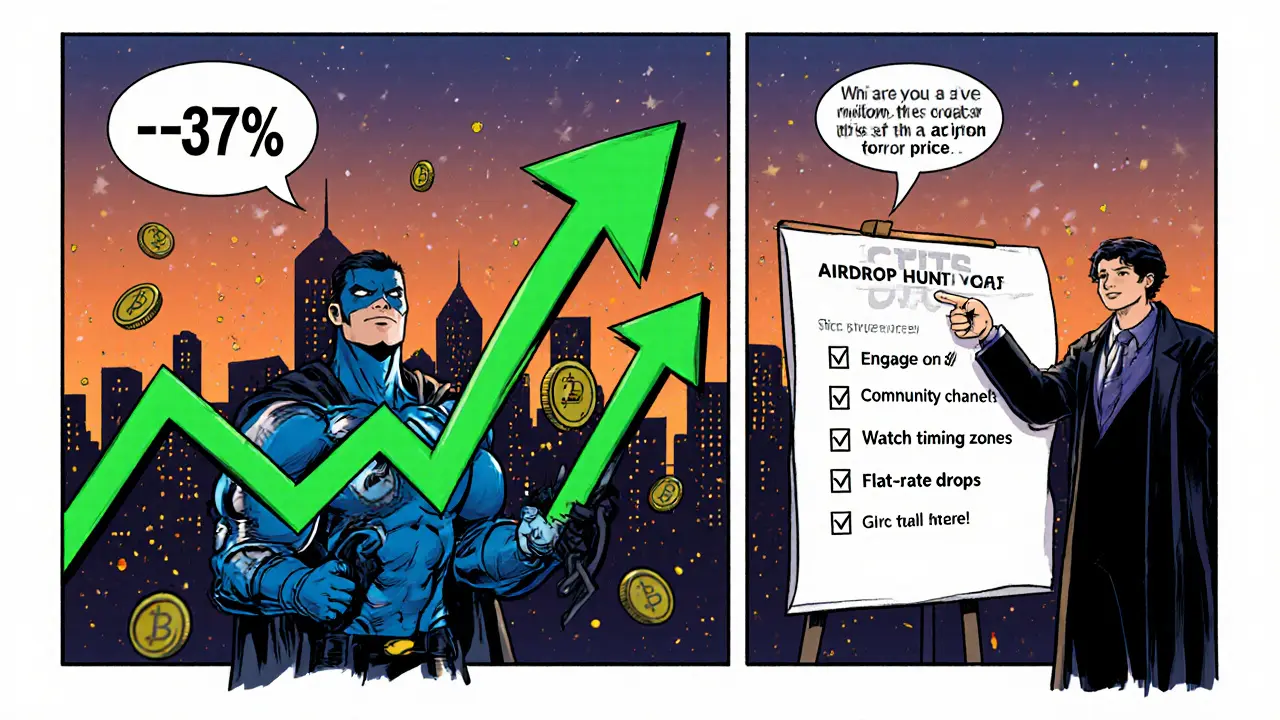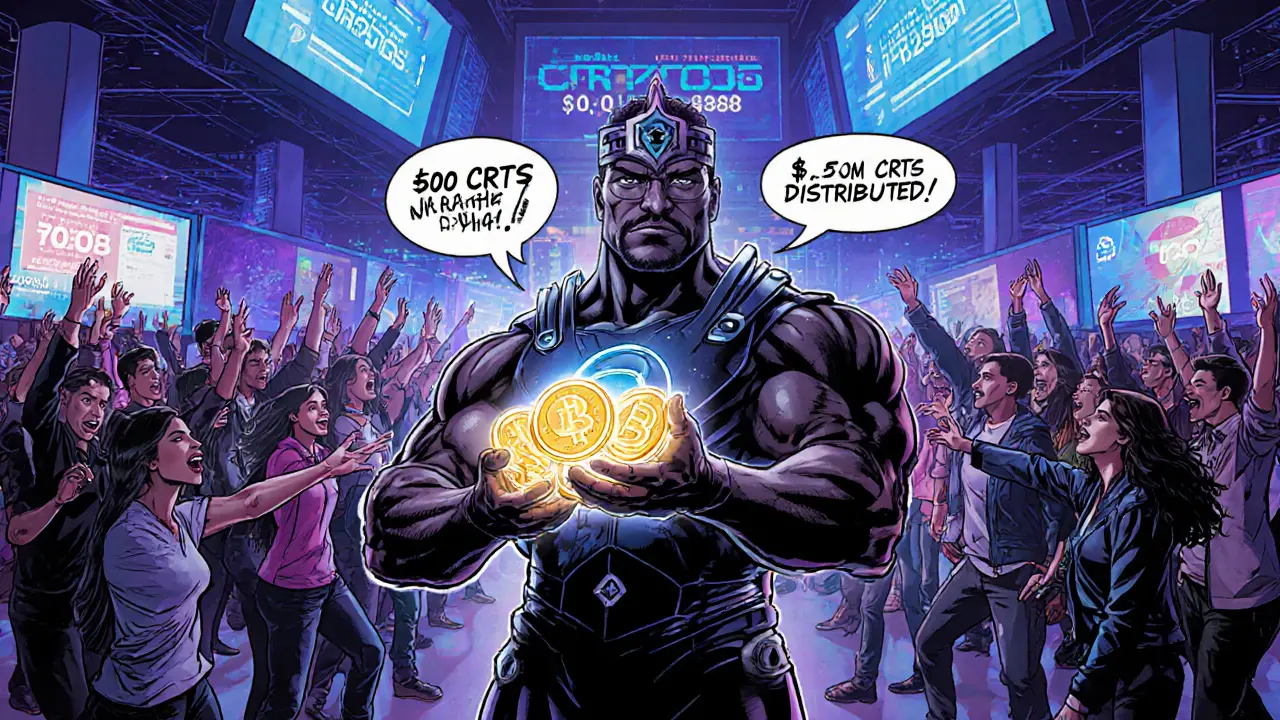Cratos (CRTS) Airdrop Calculator
Airdrop Overview
Cratos distributed 2.5 million CRTS tokens to 5,000 winners, with each winner receiving 500 CRTS. The token price at announcement was $0.00029888.
Airdrop Summary
Total Tokens Distributed:
Total Value of Airdrop (USD):
Average Value Per Winner (USD):
Estimated Market Cap (if all tokens were sold at current price):
When Cratos announced its Cratos airdrop in mid‑2024, the crypto community took notice. The event promised 500 CRTS tokens to each of 5,000 winners, flooding the market with 2.5million new coins. If you’re wondering what made this drop stand out, how the mechanics were set up, and whether the price boost was real, you’re in the right place. Below you’ll find a step‑by‑step breakdown, hard numbers, and a quick comparison to other notable airdrops from the same year.
Quick Takeaways
- 500 CRTS tokens per winner, 5,000 winners total → 2.5million CRTS distributed.
- Distribution deadline: 5July2024, 08:00UTC+9 (Asia‑focused timing).
- Token price at announcement: $0.00029888 → each allocation worth ~ $0.15.
- Market cap before the drop: $18.7million; daily volume: $29.6million.
- Price jumped 37% from announcement to the day after, with a sustained 18.6% daily gain.
What Is the Cratos (CRTS) Token?
Cratos is a blockchain platform that aims to provide high‑throughput, low‑fee transactions for decentralized applications. The native cryptocurrency, CRTS, powers the network’s staking, governance, and fee‑payment mechanisms. At the time of the airdrop, the token’s circulating supply sat at roughly 62.8billion CRTS, giving it a low per‑token price that made mass distribution feasible.
How the Airdrop Was Structured
The Cratos team kept the mechanics straightforward:
- Identify 5,000 community members who demonstrated active participation (social media posts, Discord chatter, or on‑chain activity).
- Allocate a flat 500 CRTS to each selected address.
- Execute the distribution in a single on‑chain transaction on 5July2024 at 08:00UTC+9.
This approach differed from many 2024 airdrops that used multi‑phase claim windows or required users to complete complex tasks. Cratos wanted an immediate boost to token circulation and community awareness, so they opted for a single‑shot, “you‑are‑in‑or‑you‑are‑out” model.
Key Metrics at Drop Time
Market capitalization stood at $18.7million, calculated from the circulating supply and the $0.00029888 token price. The daily trading volume averaged $29.6million, indicating healthy liquidity for a mid‑tier token.
Price reaction was dramatic: the moment the airdrop was announced, the token climbed 18.64% in a single day, followed by a 17.70% surge the next day, and a cumulative 37.33% rise from the original announcement price. These numbers suggest the market rewarded the clear, generous distribution model.

Why the Timing Made Sense
July2024 was a relatively active month for crypto markets. Traders were looking for fresh catalysts, and airdrops were a proven way to generate buzz. By setting the deadline at 08:00UTC+9, Cratos targeted Asian exchanges and communities, which historically provide high on‑chain activity during their business hours. This timing helped ensure that the token’s price impact would be felt across major Asian markets first, before spilling over to North America and Europe.
Community Participation Requirements
Cratos kept eligibility simple: any community member who could demonstrate genuine engagement qualified. The project promoted the drop on Twitter, Telegram, and Discord using hashtags like #CRATOS2024 and #Airdrop. While the exact algorithm for selecting the 5,000 winners wasn’t publicly disclosed, the general rule was that active participants-those who posted, shared, or interacted with the project’s official channels-had higher odds.
How Cratos Compared to Other 2024 Airdrops
| Project | Total Tokens Distributed | Average Value per Allocation (USD) | Winners | Key Differentiator |
|---|---|---|---|---|
| Cratos (CRTS) | 2.5million CRTS | ~0.15 | 5,000 | Flat 500‑token grant, immediate claim |
| Ethena | 5million ETHENA | ~0.80 | 10,000 | Educational‑task based eligibility |
| PENGU | 3million PENGU | ~0.30 | 7,500 | Multi‑phase claim windows (30days each) |
| Hyperliquid | 1.2million HLIQ | ~2.00 | 2,000 | High‑value, low‑winner count, targeted to traders |
The table shows that Cratos opted for breadth over depth: more winners, lower individual value, and a single‑step claim. Projects like Hyperliquid chased high‑value participants, while Ethena focused on education‑driven outreach. In the broader 2024 airdrop landscape, Cratos sits in the middle tier-big enough to generate market movement but modest enough to stay within a community‑first philosophy.
Post‑Airdrop Performance and Long‑Term Impact
After the distribution, CRTS continued to trade above the pre‑airdrop price for several weeks. The 37% jump gave early holders a noticeable paper profit, and the increased volume helped cement liquidity on major exchanges. However, the token’s price settled to a range between $0.00035 and $0.00045 within two months, indicating that the initial hype gradually normalized.
From a tokenomics perspective, adding 2.5million CRTS to an existing supply of 62.8billion represented a negligible inflationary pressure (<0.004%). This low dilution helped maintain confidence in the project’s long‑term roadmap, which includes upcoming DeFi modules and a staking rewards program slated for 2025.
Lessons for Future Airdrop Hunters
If you’re scouting for the next airdrop, Cratos offers a few takeaways:
- Keep an eye on community channels. The project selected winners purely on engagement, so regular activity on Twitter, Discord, and Telegram pays off.
- Flat‑rate drops can generate sizable short‑term price moves, especially for low‑price tokens where even a few hundred coins add up to a handful of dollars.
- Timing matters. Aligning the claim window with high‑traffic time zones can amplify market impact.
While the Cratos airdrop is now history, the mechanics it used still shape how new projects design their token distributions in 2025 and beyond.

Frequently Asked Questions
Did I miss the Cratos airdrop deadline?
Yes. The claim period closed on 5July2024 at 08:00UTC+9. Tokens were automatically sent to the winners’ wallets, and there is no retroactive claim option.
How many CRTS tokens are in circulation now?
As of October2025, the circulating supply is about 63.5billion CRTS, reflecting ongoing staking rewards and modest new issuance.
Can I still buy CRTS on exchanges?
Yes. CRTS is listed on several midsize exchanges. Prices hover around $0.00040, but always check the latest order book for accurate rates.
What made Cratos’ airdrop different from other 2024 drops?
The flat‑rate 500‑token grant, immediate distribution, and focus on simple community engagement set it apart from multi‑phase or high‑value, low‑winner models.
Will Cratos do another airdrop in 2025?
The team hinted at a “staking reward boost” later in 2025, but no formal airdrop has been announced yet.



bob newman
May 4 2025Sure, the airdrop was just a front for the Illuminati to siphon crypto taxes.
Anil Paudyal
May 9 2025Looks good.
you can use the calculator to see your share.
Kimberly Gilliam
May 14 2025Wow what a ride the CRTS airdrop was.
The numbers are insane.
5k winners each got 500 tokens.
That sounds generous but also a cash grab.
I guess the hype will die soon.
Jeannie Conforti
May 19 2025i think the drop was rad its cool for new users.
getting 500 tokens feels like a small win but it's a start.
hope the community keeps the vibe up.
tim nelson
May 24 2025Reading through the numbers reminded me how airdrops can be both a blessing and a pressure cooker for a fledgling ecosystem.
First, the sheer volume of 2.5 million tokens entering circulation in one fell swoop is enough to jolt any market, especially one that already had modest liquidity.
Second, spreading those tokens across 5,000 wallets means the average holder ends up with a tiny fraction of the total supply, which can feel like a token of appreciation rather than meaningful stake.
Third, because the token price was under a tenth of a cent, the dollar value per wallet was only about fifteen cents – not enough to change anyone’s financial outlook.
Fourth, the timing of the airdrop during a relatively active market month amplified the price bounce, as traders rushed to buy on the news.
Fifth, the post‑airdrop volume spike of nearly $30 million a day shows how many participants were quickly moving the coin, possibly looking for quick profit.
Sixth, the price rise of 37 % after the announcement proved that the community responded positively, at least in the short term.
Seventh, the subsequent stabilization between $0.00035 and $0.00045 indicates that the hype eventually settled and the market found a new equilibrium.
Eighth, from a tokenomics perspective, adding 2.5 million to a 62.8 billion supply is a minuscule inflationary pressure, but the perception of dilution can still spook holders.
Ninth, the flat‑rate distribution model avoided the complexities of multi‑phase claims, which probably helped keep the process transparent and swift.
Tenth, however, the lack of a clear algorithm for winner selection leaves room for speculation about fairness.
Eleventh, community members who actively engaged on Discord and Twitter were understandably advantaged, reinforcing the need for consistent outreach.
Twelfth, the Asian‑focused timing likely gave a boost in those markets before the news filtered westward.
Thirteenth, the airdrop’s modest individual value makes it accessible to a wider audience, encouraging broader adoption.
Fourteenth, the price volatility after the drop highlights both opportunity and risk for new participants.
Fifteenth, overall, the Cratos airdrop serves as a textbook case of how well‑executed token distribution can create a temporary surge while laying groundwork for longer‑term community growth.
Zack Mast
May 29 2025In the grand tapestry of cryptographic evolution, the Cratos airdrop is a fleeting echo of the collective yearning for decentralised sovereignty.
It whispered to us that even the smallest grain of token, when multiplied across thousands, can stir the tides of perception.
The nation‑state of crypto was momentarily reminded that borders are meaningless when a blockchain transaction hops from Tokyo to Toronto in a heartbeat.
Yet, beneath the pomp, there lies a pragmatic engine – an engine that fuels the next generation of dApps with cheap, fast transactions.
Let us not be blind to the fact that this token distribution was also a subtle rallying cry for a more inclusive financial order.
When you look beyond the numbers, you see a manifesto: give every participant a slice, however modest, and you empower the masses.
Dale Breithaupt
June 3 2025Hey folks, the flat 500‑token grant is a solid way to get newbies onboard fast.
Short and sweet, no endless claim windows.
Let’s keep the momentum going and support each other as the ecosystem grows.
Rasean Bryant
June 8 2025The airdrop’s simplicity is refreshing, and the modest $0.15 value per winner makes it accessible to everyone.
Looking forward to seeing how the community builds on this foundation.
Angie Food
June 12 2025Another airdrop, another smoke‑and‑mirrors routine – they throw out a few tokens, hype the market, then disappear.
Seems like a classic pump‑and‑dump in disguise.
Jonathan Tsilimos
June 17 2025From a quantitative perspective, the Cratos distribution exhibits a breadth‑oriented allocation model whereby the token dispersion ratio (500 tokens / total supply) remains negligible, thereby mitigating immediate inflationary impact; however, the resultant liquidity influx precipitates heightened volatility indices, necessitating vigilant market‑making strategies to stabilize post‑drop equilibrium.
jeffrey najar
June 22 2025If you’re wondering how to interpret the airdrop numbers, think of the 2.5 million tokens as a way to seed the community with a low‑cost entry point.
It’s enough to get people interested without overly diluting the existing supply.
Use the calculator to see your potential dollar value and compare it to the current market cap for context.
Rochelle Gamauf
June 27 2025While the Cratos airdrop may appear generous at first glance, a discerning observer notes that the per‑recipient valuation of merely $0.15 is insufficient to engender substantive stakeholder commitment, rendering the distribution a superficial promotional tactic rather than a substantive investment in ecosystem vitality.
Jerry Cassandro
July 2 2025Curious about the long‑term effects – do we have any data on how many of the 5,000 winners actually held the tokens versus sold them immediately?
Parker DeWitt
July 7 2025Looks like another staged giveaway 🤔💰🚀
Allie Smith
July 12 2025i think the airdrop is like a seed planted in a garden, it might not grow fast but over time it could blossom into something beautiful.
Lexie Ludens
July 17 2025The drama of these drops never ceases – a flash of hope, then a tidal wave of disappointment as the price settles.
Such fleeting euphoria is a symptom of a market that thrives on hype more than substance.
Aaron Casey
July 21 2025From a technical standpoint, injecting 2.5 million CRTS into the circulating pool imposes a negligible shift in the token’s supply‑demand curve, yet the short‑term liquidity surge necessitates robust on‑chain governance mechanisms to mitigate price slippage.
Leah Whitney
July 26 2025Great breakdown! It helps to see the numbers put into context.
Lisa Stark
July 31 2025It’s fascinating how a single distribution can act as both a catalyst for community growth and a test of market resilience.
Logan Cates
August 5 2025Sure, let’s hand out free tokens and pretend it’s not just another way to stir up speculation.
scott bell
August 10 2025The Cratos airdrop feels like a subtle invitation to join the next wave of blockchain innovation, yet it also underscores the volatile nature of token economics that can leave newcomers bewildered.
vincent gaytano
August 15 2025Of course the whole thing is a ploy by the elite to funnel crypto into their secret vaults – classic.
Kimberly M
August 20 2025Thanks for the info! 😊
Navneet kaur
August 25 2025i cant believe they think giving 500 tokens is enough. its just a token gesture.